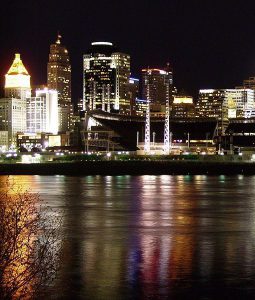Cincinnati has a rich and powerful history. So, what turned it from an awkwardly named Losantiville to a fine city with theme parks, festivals, monuments, halls, and other treasures? I am very glad you asked. I would like to introduce you to some highlights of Cincinnati’s history.
The Beginnings
 So, the city was originally not one, not two, but three separate settlements. Losantiville was the central settlement, with the other two being Columbia and North Bend. These three settlements came to be in 1788. Just a year later, a fort was built as protection for the settlements. Fort Washington, as you can already guess, was named after the first president of the United States, George Washington. The Governor of Northwest Territory, Arthur St. Claire, renamed the place Cincinnati, after a Roman dictator who was originally a farmer and came back to it voluntarily after there was no more need for him to be in power.
So, the city was originally not one, not two, but three separate settlements. Losantiville was the central settlement, with the other two being Columbia and North Bend. These three settlements came to be in 1788. Just a year later, a fort was built as protection for the settlements. Fort Washington, as you can already guess, was named after the first president of the United States, George Washington. The Governor of Northwest Territory, Arthur St. Claire, renamed the place Cincinnati, after a Roman dictator who was originally a farmer and came back to it voluntarily after there was no more need for him to be in power.
The Rapid Growth
 Cincinnati was one of the fastest-developing communities in the 19th century. In 1811, steamboats became quite popular, which allowed the city to connect with others, like St Luis, Missouri, and New Orleans. The city was struggling between the 1810s and 1830s to find enough workers. You may know that there were cities in the US that loved using work ads like “Help Wanted: The Irish Need Not Apply”. Luckily, this was not the case with Cincinnati, where a huge wave of the Irish and the Germans brought not only the workforce but a few special cultural traits concerning food and drinks.
Cincinnati was one of the fastest-developing communities in the 19th century. In 1811, steamboats became quite popular, which allowed the city to connect with others, like St Luis, Missouri, and New Orleans. The city was struggling between the 1810s and 1830s to find enough workers. You may know that there were cities in the US that loved using work ads like “Help Wanted: The Irish Need Not Apply”. Luckily, this was not the case with Cincinnati, where a huge wave of the Irish and the Germans brought not only the workforce but a few special cultural traits concerning food and drinks.
The testament to how well the people coordinated in the city over the century is the fact that Cincinnati made it out of the Great Depression much better than most cities in the US. In fact, while the others were trying to patch their problems, the city was building as it was on the river and that type of transportation became the most affordable.
Nicknames
 One of the most popular nicknames the place got was about three decades after it was recognized as a city in 1802. Its first nickname was Porkopolis, due to pork and herds of hogs in the streets, as well as the fact that it was the hub of all things pork in the region. Another nickname the city earned was the City of Seven Hills, which was the nickname for Rome.
One of the most popular nicknames the place got was about three decades after it was recognized as a city in 1802. Its first nickname was Porkopolis, due to pork and herds of hogs in the streets, as well as the fact that it was the hub of all things pork in the region. Another nickname the city earned was the City of Seven Hills, which was the nickname for Rome.
Those that follow my blog already know that I have referred to Cincinnati as the Queen City, the Queen of the West, and even the Blue Ship City once. All of these are legitimate nicknames that Cincinnati acquired over the years.
Modern Years
 The thing about Cincinnati is that it never became irrelevant to the nearby communities. Its ability to thrive in the most difficult circumstances makes the place a pretty good place to live. That being said, it is not like poverty doesn’t exist here. In fact, you can find people from all walks of life in the city. As the companies moved to the suburbs and larger portions of the population were unable to follow them, thus mission out on jobs, the authorities have been working round the clock since 2015 to revitalize the city and give the people the jobs they need. The unemployment rate at the time of writing stands at a mere 3.7%, and that’s not even a record low for us.
The thing about Cincinnati is that it never became irrelevant to the nearby communities. Its ability to thrive in the most difficult circumstances makes the place a pretty good place to live. That being said, it is not like poverty doesn’t exist here. In fact, you can find people from all walks of life in the city. As the companies moved to the suburbs and larger portions of the population were unable to follow them, thus mission out on jobs, the authorities have been working round the clock since 2015 to revitalize the city and give the people the jobs they need. The unemployment rate at the time of writing stands at a mere 3.7%, and that’s not even a record low for us.
